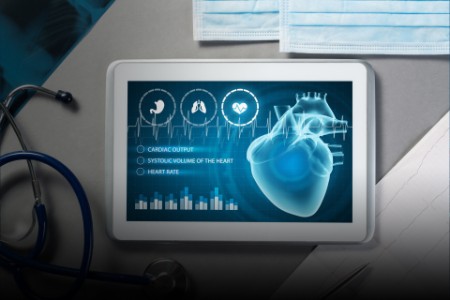The low latency in 5G provides for higher-quality virtual interactions (such as 4k video calls), and faster sharing of heavy data files (such as high-resolution images). It also has the potential to achieve real-time interactivity of medical equipment and remote wearable devices that can then record patients’ healthcare data, analyze it, and communicate with healthcare providers in real-time, paving the way for better remote care (such as robotic surgeries, at-home care, etc.). With 5G connectivity, EMTs in an ambulance can share a patient's symptoms, vitals, and medical records with the hospital staff in real-time. They can apprise doctors of the situation through video calls and help them prepare in advance.
Wearables and AI-enhanced apps can use 5G technologies to apply machine learning to health-related data analysis, from diagnosis to emergency medical attention. Doctors can tap VR-based technologies to better explain diagnoses to patients, and medical practitioners can collaborate remotely, get training on complex procedures, etc.
As an enabler for several more services and solutions, 5G has the potential to improve patient experience and drive transformational change within the sector. It can open the door to a new age of opportunities, especially among the under-serviced communities in rural and remote areas, who currently struggle to access quality and affordable healthcare.
5G opens up the possibility of building an intelligent network in the healthcare ecosystem, where the various stakeholders such as patients, doctors, hospitals, laboratories, and ambulances exchange real-time information through a secured central network and pave the way for seamless omni-channel play.
Omnichannel platforms
Historically, healthcare service delivery has been an offline affair dominated by traditional hospitals, diagnostic players, and pharmacies. This changed briefly when COVID-19 restrictions forced patients to adopt online means of availing healthcare. With the return of in-person healthcare post COVID-19, healthcare players are realizing that to drive cost-effective and meaningful care to address evolving patient behavior, it is essential to have interoperability between in-person and virtual care.
E-health players are, therefore, adopting a broader omnichannel healthcare delivery model to become a one-stop solution provider for patients. Companies that originally started with online-only services, such as e-pharmacies or e-diagnostics, are now evaluating offline models to register their presence across both channels. For example, an online e-health player is opening offline pharmacies and lab centers to complement its e-pharmacy and e-diagnostics services. Further, to address patients’ medical needs across the treatment lifecycle, some e-health players are adding healthcare at home services, which requires integrating online and offline services.
As e-health players explore offline play, many traditional hospital chains are stepping into the online play with plans to become comprehensive omni-channel providers. This not only enables them to increase their share of wallet by addressing patient’s needs across the treatment lifecycle, but it also allows a broader reach to patients and strengthening brand equity. For example, a pan-India hospital chain group has launched an omni-channel platform, which provides patients with online access to the existing network of pharmacies, hospital labs and hundreds of specialist doctors empaneled with network hospitals.
Omni-channel presence will also help healthcare companies improve their understanding of patient preferences, which will allow them to develop tailored services and continuously optimize engagement through analytics and new age digital capabilities. This would lead to increased patient satisfaction, resulting in longer patient retention.
For patients, an omnichannel approach to healthcare allows seamless access across their preferred modes of delivery (online or offline) while maintaining the continuum in treatment.



